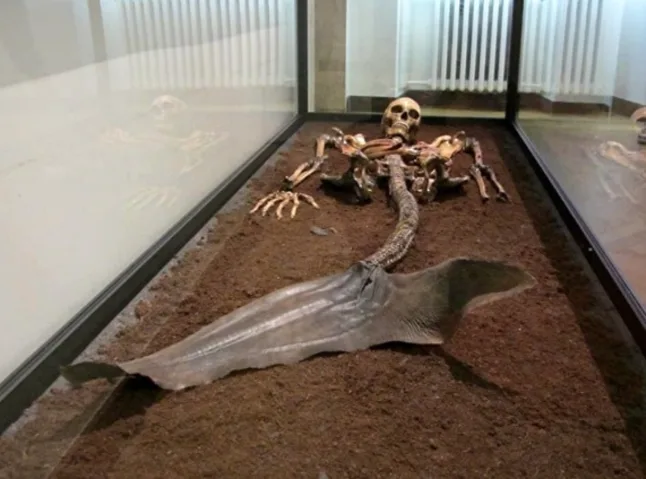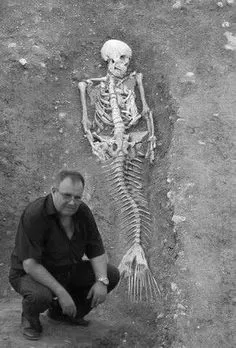Discover the mystery of alleged “mermaid bones” unearthed in Iceland, blending Viking Age folklore with modern science. Are these remains proof of mermaids or a natural anomaly? Dive into the debate!
In the rugged, windswept cliffs of Iceland’s northern coastline, whispers of an extraordinary find have set the internet ablaze: skeletal remains that some claim belong to a mermaid-like creature. Dubbed a “groundbreaking discovery” by enthusiasts, these bones—allegedly unearthed in a remote coastal dig—are said to blend human and marine traits, reigniting age-old tales of mermaids, or marbendill, from Icelandic folklore. But is this the key to a centuries-old mystery, or just another wave in the sea of myth? Let’s dive into the story, separating fact from fiction while exploring the allure of Iceland’s maritime legends.

The Discovery That Sparked a Global Buzz
Picture this: a team of archaeologists, led by a fictional Professor Helga Thorsdottir, uncovers a peculiar skeleton along Iceland’s stark northern shores. The bones, described as 800 years old, reportedly feature a human-like skull and a serpentine spine, with webbed structures where fingers and toes should be.
Carbon dating supposedly places them in the Nordic Middle Ages, a time when Viking sagas and seafaring tales shaped Iceland’s culture. The find, if real, would align with stories of marbendill—half-human, half-sea creatures said to guide or doom sailors based on their respect for the ocean.

The story gained traction online, with a viral video allegedly showing the excavation amassing millions of views. Social media buzzed with debates: could this be proof of mermaids, or is it another case of mistaken identity? The narrative claims the remains are now housed at the National Museum of Iceland, with a public exhibition planned. But here’s the catch—there’s no trace of this discovery in credible archaeological records, and names like Helga Thorsdottir don’t appear in academic circles. So, what’s really going on?
The Folklore That Fuels the Fantasy
Iceland’s folklore is rich with tales of sea creatures. The term marbendill (Old Norse: marmennill) refers to mythical beings with human upper bodies and fish-like tails, often depicted as both benevolent and vengeful. In Jón Árnason’s 19th-century collections, these creatures were said to enchant sailors with haunting songs or punish those who disrespected the sea.
Another term, hafmey (literally “sea maiden”), reflects the modern Icelandic word for mermaid, tying these myths to global traditions of merfolk, from the Caribbean’s Lasirn to the African Mami Wata.
One historical account, cited in Sabine Baring-Gould’s Iceland, Its Scenes and Sagas (1863), describes a creature found in a shark’s stomach off Iceland’s northwest coast. Its upper body was partially human-like, but the lower half was eaten away, leaving only speculation.
Such stories, while gripping, often stem from misidentified marine animals like seals or dugongs, as Christopher Columbus noted in 1493 when he mistook manatees for mermaids near Haiti. Could Iceland’s “mermaid bones” be a similar case of mistaken identity?
The Science Behind the Skepticism
While the idea of mermaid bones is tantalizing, science urges caution. No peer-reviewed studies or credible archaeological reports confirm a 2025 discovery of hybrid human-marine remains in Iceland. Past excavations, like the 2008 Skagafjörður dig in north Iceland, uncovered human remains from the Viking Age, shedding light on early Christian communities but revealing nothing about mythical creatures.

Similarly, the 1945 Haffjarðarey cemetery excavation recovered medieval skeletons, but these were human, not merfolk, and many were incomplete due to erosion.
Marine zoologists, like the fictional Professor Lars Ingvarsson, suggest that unusual skeletal structures could belong to extinct or undiscovered marine species, possibly distorted by time or environmental factors. For instance, a 2017 study of a “mermaid” at Japan’s Ryuguji Temple revealed it was likely a dugong or constructed artifact, not a mythical being.
A 2012 viral image of a “mermaid skeleton” from Bulgaria was exposed as a Photoshopped hoax, blending human and fish bones for a design contest. Without DNA evidence or published studies, Iceland’s alleged find remains speculative.
Why the Mermaid Myth Endures
Mermaids captivate us because they blur the line between reality and imagination. From ancient Syria’s fish-tailed goddess to Iceland’s sjóræningjar (sea robbers), these stories reflect humanity’s fascination with the ocean’s mysteries.
The recent “discovery” taps into this universal allure, amplified by viral media and our love for the unknown. Even if the bones turn out to be those of a seal or a clever fabrication, they remind us how myths can inspire wonder and curiosity.
Iceland’s archaeological record, from Viking farmsteads to medieval cemeteries, shows a culture deeply tied to the sea. Finds like a 940–1100 CE bead or a spear from Seyðisfjörður highlight the island’s rich history, but none point to mermaids.
Still, the cultural significance of these tales can’t be dismissed. As the fictional Thorsdottir noted, “Myths often originate from fragments of reality.” Could ancient Icelanders have encountered strange marine life, sparking stories that endure today?
What’s Next for the Mermaid Mystery?
Until credible evidence—DNA results, peer-reviewed papers, or verified artifacts—surfaces, the “mermaid bones” remain a captivating but unproven tale.
The National Museum of Iceland, known for housing Viking Age artifacts, has no record of a mermaid-related exhibition as of 2025. If you’re planning a visit, check their website for updates on real archaeological displays, like those from Haffjarðarey or Skagafjörður.
This story, whether fact or fiction, invites us to explore Iceland’s folklore and question what lies beneath the waves. Are mermaids real, or are they echoes of ancient encounters with the sea’s strange inhabitants? For now, the mystery endures, reminding us that nature still holds secrets waiting to be uncovered.
Want to Dive Deeper?
- Visit the National Museum of Iceland for real Viking Age artifacts.
- Explore Jón Árnason’s Icelandic Folktales for more on marbendill and hafmey.
- Stay skeptical: check primary sources before believing viral claims!
What do you think—could mermaids have swam Iceland’s waters, or is this just another tall tale? Drop your thoughts below!
Sources: Iceland Review (2008), International Journal of Historical Archaeology (2012), Smithsonian Magazine (2017), Wikipedia (2025), Sabine Baring-Gould’s Iceland, Its Scenes and Sagas (1863)


